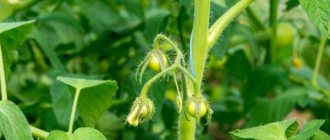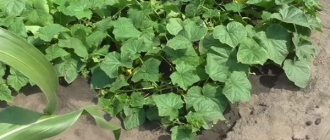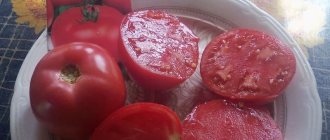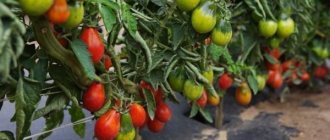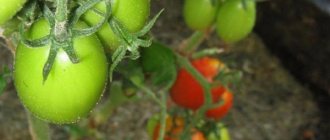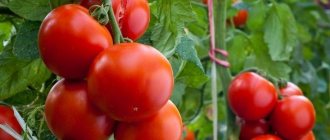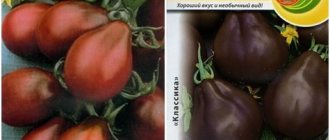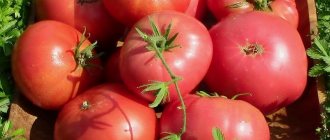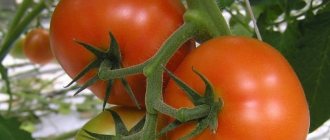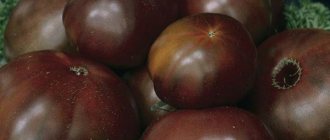The numerous variety of tomato crops often complicates rather than simplifies the choice of gardeners. Especially when it comes to choosing between a varietal crop and a hybrid. It is believed that the pure variety has better taste. But the miracles of selection have achieved excellent taste in hybrid varieties. One of these representatives is the Velikosvetsky tomato. It will not only decorate any festive table, but will also satisfy any high society nobleman with its taste.
Further in the article - characteristics and description of the hybrid, yield and growing rules.
Characteristics and description of the variety
Hybrid f1 Velikosvetsky is included in the State Register of Breeding Achievements in 2021. The applicant indicated .
Distinctive features
The type is indeterminate, height 1.5-2 m. With such growth, the plants must be tied up and pinched to prevent the plantings from becoming dense.
The ripening period is early, from the moment of sowing the seeds to full ripening, 105-110 days pass.
The productivity is high, 5 kg of fruits are harvested from 1 seedling, provided that 3-4 plants are planted per 1 square meter. m.
The hybrid genes contain increased resistance to major diseases, such as late blight, tobacco mosaic virus and fusarium. The culture is also immune to bacterial infections.
The hybrid is suitable for cultivation in open ground and in greenhouse conditions.
Fruit characteristics
Each cluster forms 5-8 fruits, the average weight of which is 130-140 g. The shape is cuboid, slightly elongated, the color is bright red. The taste is pronounced, sweet with a slightly noticeable sourness. The pulp is dense, juicy, there are 3 seed chambers, few seeds.
The peel is durable and not prone to cracking. For this reason, the fruits are used for preparing preserves and marinades, as they withstand heat treatment well. The variety belongs to the salad variety, so ripe vegetables are ideal for preparing various fresh dishes.
The photo shows the Velikosvetsky hybrid.
Fruit characteristics
What is so unusual about its fruits?
First of all, the shape of the tomato is interesting. At first glance, it seems that this is ordinary cream. But if you look closely, it becomes obvious that the tomatoes have a cuboid shape, slightly elongated. They actually have four smooth edges.
And almost all the fruits in the clusters are calibrated by weight and size. You will not find a difference in fruit weight of this hybrid even by 100 grams. The average weight of a tomato is 135 grams and deviations from it will be within 10-20 grams. High society tomatoes are collected in bunches, each with 5 to 9 fruits ripening.
The color of tomatoes is standard red, and even if you see a dark spot at the base of the stalk on unripe green fruits, there is no need to worry. As it matures, it will completely disappear.
The pulp of the Velikosvetsky tomato is dense, fleshy and juicy. The skin is thick, some may find it too thick.
But the taste of these tomatoes is excellent. Tasters give the Velikosvetsky tomato the highest rating - 5 points. The tomatoes are sweet, with a barely noticeable, harmonious acidity and aromatic. There are three seed chambers and there are few seeds in them, which is typical for gourmet and salad varieties.
According to their use, Velikosvetskie tomatoes are called universal tomatoes. Although their appearance makes them ideal for canning, they are also tasty in salads and for preparing a variety of main courses.
How to grow seedlings
To grow full-fledged seedlings, seeds are sown 2 months before planting in the ground. But before sowing, the seed material is carefully prepared.
Seed preparation
Initial preparation consists of rejecting the seed material, checking for emptiness and disinfection. Rejection is carried out by careful inspection for the presence of visible defects. Seeds that are light in color, without bending or external damage, are left for germination.
Check for emptiness by immersing in a saline solution for 10 minutes. A saline solution is prepared from 1 teaspoon of salt dissolved in a glass of water. Those grains that float to the surface are disposed of; they are not suitable for sowing. Disinfect the seed material in a pink solution of potassium permanganate for 20 minutes. After disinfection, the seeds are washed with running water and dried thoroughly.
To increase germination, grains are soaked in a growth stimulator for 10 hours. It is not necessary to use specialized drugs as a stimulant. Potato juice and aloe juice perform the same function.
Reference! Aloe juice additionally disinfects seed material, strengthening the immune system.
Container and soil
A common wooden box or individual containers, for example, peat or plastic cups, are used as planting containers. They are prepared in advance by treating them in a solution of potassium permanganate. Disinfection of planting containers is necessary, especially if it was used for planting last year. Drainage holes are made at the bottom of the containers to drain excess moisture and some small pebbles or sawdust are placed.
The soil is prepared from turf soil, peat and humus in equal quantities. After thoroughly mixing all the components, add a little wood ash to the resulting mixture. Stir again and pour the prepared soil with a hot solution of potassium permanganate to destroy pathogenic flora.
Reference! Wood ash saturates the soil with useful substances necessary for the full development of seedlings.
The soil is laid out in planting containers, filling them halfway. During the subsequent growth of seedlings, the remaining soil is added to the containers, thus providing the sprouts with additional nutrition.
Sowing
The seeds are buried 1 cm. If sown close to the surface, the grains will germinate along with the shell, which will slow down their further growth. After sowing, the soil is watered with a spray bottle with warm, settled water and the containers are covered with film to create a greenhouse effect. Until the seeds germinate, the containers are left in a warm room at a temperature of 25°C.
Reference! When creating a greenhouse effect, seed material germinates faster.
Seedling care
A week later the first shoots appear. The film is removed and the containers are moved to a well-lit place on the windowsill. During the first week, it is especially important to observe the length of daylight hours and temperature conditions. Receiving sufficient light is possible when the daylight hours are 13 hours. If necessary, install phytolamps. The temperature is reduced to 15°C, and after 6 days raised to 24°C. This is how the first hardening of seedlings occurs.
Water with warm, settled water using a shallow watering can along the edge of the containers. Water lightly as the top layer of soil dries out.
When 2 true leaves appear, the seedlings are picked and placed in separate containers. When picking, the main root is shortened by one third for further growth of the root system.
During the seedling period, seedlings are fed twice. The first fertilizing is applied 10 days after picking. The second time is fed 2 weeks after the first. Liquid fertilizers are used as fertilizing for tomato seedlings.
2 weeks before transplantation, seedlings are hardened off. To do this, they are taken out into the open air for 40 minutes. Every day, the time spent on the street is gradually increased to 10 hours.
Important! When hardening plants, the outside temperature should be at least 12°C.
How to grow tomatoes
After 2 months, the seedlings can be planted in the ground. The beds for tomatoes are prepared in advance, choosing a place that is sunny and protected from drafts.
Landing
Transplant into holes 15-20 cm deep in the evening or early morning. Replant with a clod of earth, deepening the seedlings to the first leaves. The soil is compacted and watered with warm, settled water. After watering, the soil is loosened and the seedlings are left to get used to the new place for 10 days.
Planting pattern: 40 cm – distance between seedlings, 60 cm – row spacing. For 1 sq. m place 3 – 4 plants.
Further care for the Velikosvetsky tomato
Proper watering is the key to healthy plant growth. The tomato is watered rarely, but abundantly, once a week in normal weather. On dry days, the amount of watering is increased to 2-3 times. Water with settled water, strictly at the root, without getting on the leaves. To retain moisture in the beds, they are mulched with peat or straw.
After watering, the soil is loosened, thereby improving the air permeability of the soil. Along with watering, weeding the beds is also important. In weeds, fungal diseases quickly spread and pests multiply.
The minimum number of feedings per season is at least 3. But to achieve the best amount of fruiting, plants are fed once every 3 weeks.
A full complex of mineral fertilizers with a predominant content of phosphorus and potassium is used as fertilizing. Fertilizing with organic matter, for example, bird droppings in a ratio of 1:15, is also considered a good option.
Reference! For tall plants, nitrogen-containing fertilizers are used only at the initial stage, since nitrogen promotes enhanced growth.
Features of care and possible difficulties
When transplanting, a vertical wooden or metal support is installed next to each bush. The height of the stem requires a mandatory garter, otherwise it will not support the weight of numerous fruits. In addition, the plant may be damaged by precipitation and gusts of wind. Also, instead of a vertical support, you can use a horizontally stretched wire. This fixation option is considered the best, since neither the stem nor the branches are injured.
Reference! When fixed to a horizontal support, the fruits are formed slightly larger.
The pinching procedure is needed to increase the quantitative indicator of fruiting. In addition, when removing numerous unnecessary shoots, the possibility of thickening of plantings is eliminated.
The bush is led in 1, 2 or 3 stems. When formed into 1 stem, the highest yield is observed.
Diseases and pests
Traditional methods are often used to prevent diseases, since they are cheaper and safer than chemicals.
The bushes are sprayed with a weak solution of potassium permanganate, thereby preventing the occurrence of fungal and bacterial infections. Potassium permanganate can be replaced with ash, which has the same purpose.
When affected by fungus, use the drugs “Quadris” or “Fitosporin”. These substances are classified as contact fungicides.
When infested by insect pests such as aphids, slugs, whiteflies, use the Proteus insecticide or spray the plants with decoctions of fragrant herbs.
Reference! “Proteus” actively affects pests at all stages of their development, from eggs and larvae to adults.
Daily inspection of plants will protect them from the invasion of parasitic insects.
Features of cultivation
Velikosvetsky tomato seeds germinate together, there is no need to use growth stimulants, you can simply sow dry seeds in seedling containers. For rapid germination, it is advisable to maintain the temperature at +22 - +24°C. After the sprouts appear, the temperature needs to be lowered by 5-6, it is important to do this at night.
An abundance of light with relatively cool conditions (no higher than +20°C) is the key to the successful development of tomato seedlings. Picking when two true leaves are formed will help plants form a strong root system and aerial parts. The first inflorescence is formed above the 7th leaf, so you will most likely plant tomatoes with buds in a permanent place.
It is better to postpone the use of fertilizers until seedlings are planted in the ground, since intensive development of bushes is possible only with an abundance of sunlight; artificial lighting cannot replace it.
When planting bushes per 1 sq. m place no more than 3-4 plants, and then only if they are formed into one stem. This way, get the largest clusters and the fruits in them.
When grown in greenhouses, it is better to form two stems. The stepson formed under the first flower cluster is left as the second stem. In this case, the yield will be even higher, but the clusters will not be as large as when grown in one stem.
Despite all the resistance of the Velikosvetsky tomato to diseases, there are always sources of infection in the soil. For prevention, add the biological product Trichocin to the ground 2-3 days before transplanting seedlings according to the instructions. And place one Glyocladin tablet into the planting holes along with the plants.
It is better to use organic fertilizers as fertilizers, such as solutions of vermicompost, humus or humates. It is advisable to apply fertilizers during flowering and when fruit sets.
The nuances of growing in open ground and in a greenhouse
Greenhouse plants reach a height of 2 m, so pinching the crown is necessary to limit growth. When the growth point is designated, nutrients are spent on the formation of fruits, and not on the growth of unnecessary branches.
In the greenhouse, last year's top layer of soil is replaced with a new one. This is due to the fact that past plantings deplete the soil. In addition, a large number of microorganisms successfully overwinter in the upper layer, which in the spring cause considerable harm to the plantings. If there is no possibility of replacement, then the soil is carefully supplied with mineral fertilizers and disinfected with a dark solution of manganese.
Protected structures must be ventilated every day. Otherwise, increased temperature and humidity will provoke the development of fungal infections. In addition, the influx of fresh air destroys the usual habitat of many greenhouse pests.
Tomato “Velikosvetsky F1”
One of the most interesting tomatoes, the seeds of which can be found on the shelves of agricultural departments of stores, is the hybrid “Velikosvetsky F1”. Many summer residents have already successfully tested it on their garden plots.
Read on Dacha6.ru:
Description and characteristics
The plant is indeterminate and early ripening. In the conditions of central Russia, greenhouse cultivation is recommended. The height of the bushes by the end of the growing season reaches 200 cm. Fruiting occurs 100-110 days after emergence. The first flower brush is formed above the 7th leaf, and the subsequent ones are formed at an interval of 2-3 leaves from the previous ones. Each bunch produces an average of 5-7 tomatoes.
Harvesting and application
Fruits are collected based on their shelf life. If you plan to store tomatoes for a long time, then they are picked green. Ripe vegetables can be stored for no more than 2 weeks.
The use of vegetables is universal. They are ideal for preparing a variety of fresh dishes, for example: hot or vegetable dishes, various snacks, summer salads, cutting into sandwiches. Tomatoes are good in whole-fruit canning, marinades and pickles, and they are also processed into tomato products, producing delicious juices, ketchups and sauces.
Advantages and disadvantages of the variety
The variety has many positive properties:
- high productivity;
- easy care;
- possibility of breeding in open and protected ground;
- good disease resistance;
- early ripening;
- excellent taste of fruits;
- unusual cuboid shape;
- versatility in cooking.
Negative characteristics include the need for garter, regular pinching and formation of seedlings, which can cause difficulties for novice gardeners.
Farmer reviews
The photographs clearly show four smoothed edges in the shape of the fruit. Numerous reviews indicate that tomatoes are indeed not round, and this feature gives them a peculiar charm.
Valentina, Oryol region: “Summer came late this year, but the hybrid has taken root well. The first fruits appeared at the end of July. I liked the dense tomato clusters with tomatoes of the same size, like a selection. 6-8 ovaries were formed in each brush. The Velikosvetsky Tomato turned out to be a success! Original shape and excellent taste."
Tatyana, Bryansk: “The seeds of this culture were distinguished by 100% germination. I grew the hybrid in different ways: I formed it into one, two shoots or more. On the seedling where I left one stem, the most fruits ripened. Tomatoes of unusual shape and great taste. I liked that the brushes have time to mature completely and the vegetables do not crack.”
Taste qualities of Velikosvetskie tomatoes
Most people mistakenly believe that hybrid tomatoes are not as tasty as non-hybrid forms. The Velikosvetsky tomato has a sweet taste; even small children and the most discerning gourmets love the fruits. Only insufficient watering can give the fruits some sourness. To feel the true taste of the juicy, fleshy and dense pulp of the fruits of this variety, it is recommended to pick it after full ripening when it reaches a bright red color.
Important! If unripe fruits have a dark spot in the area of the stalk, there is no need to be afraid of this: it will disappear as it ripens.
